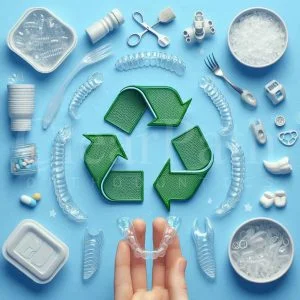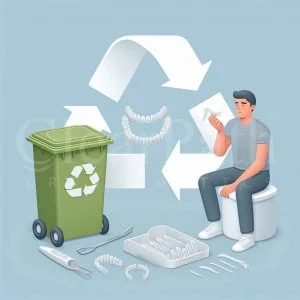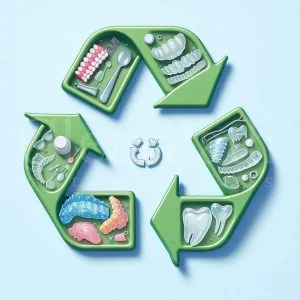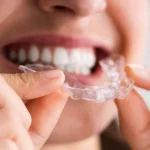In the realm of orthodontic treatment, a revolution is underway. This revolution is being led by clear aligners, a modern alternative to traditional braces that are rapidly gaining popularity.
Clear aligners, as the name suggests, are virtually invisible appliances that are custom-made to fit snugly over the teeth and gradually shift them into their correct positions.
Clear aligners have emerged as a preferred choice for many patients seeking orthodontic treatment. Their appeal lies in their discreet appearance and comfort, offering a significant aesthetic and practical advantage over metal braces.
They are removable, allowing patients to eat, drink, and maintain oral hygiene routines without hindrance.
Moreover, clear aligners are typically associated with a shorter treatment duration and fewer visits to the orthodontist, making them a convenient option for many.
The use of advanced technology in designing and manufacturing these aligners ensures a precise fit and effective treatment, contributing to their growing popularity.
Environmental Concerns: Disposal of Used Aligners
While clear aligners are transforming orthodontic treatment, they also present an environmental challenge.
Each set of aligners is worn for a short period, typically one to two weeks, before being replaced by the next set in the series.
This frequent change results in a substantial number of used aligners that need to be disposed of.
However, clear aligners are not typically recyclable due to their classification as medical waste.
This means that they often end up in landfills, contributing to environmental pollution.
The material used in clear aligners, usually a type of plastic, takes a long time to break down, further exacerbating the issue.
The environmental impact of clear aligner disposal is a concern that needs to be addressed. As the popularity of clear aligners continues to rise, so too does the importance of finding sustainable disposal methods.
This is a challenge that the orthodontic industry, environmental scientists, and policy-makers will need to tackle together to ensure that the revolution in orthodontic treatment does not come at the expense of our planet.
While clear aligners are a significant advancement in orthodontic treatment, it is crucial to consider and address the environmental implications of their use.
As we embrace this innovation, we must also commit to finding sustainable solutions for the future.
After all, a healthy smile should not cost the earth.
Understanding Aligner Material

Clear aligners are typically made from medical-grade thermoplastics, which are a mix of various types of plastics.
These materials, such as Polyethylene terephthalate glycol (PETG), Polyurethane (PU), and Multilayer aromatic thermoplastic polyurethane/copolyester (TPU), are preferred for their physical properties.
The Challenge of Recycling Clear Aligners
Despite the benefits of these materials, they pose significant challenges for traditional recycling programs.
The mix of different plastics in clear aligners complicates the recycling process.
Most recycling programs are not equipped to handle this type of mixed plastic waste, leading to clear aligners often being sent to landfills.
As Murat Tunca points out in his paper, “The Environmental Impact of Clear Aligners: Is Recycling and Waste Management Controlled?”, the treatment of an average individual involves the production of 640 cm² of thermoplastic.
When considering the reported total number of patients worldwide, this suggests the initiation of a significant plastic waste cycle associated with this treatment.
Tunca further emphasizes that while the toxicity of these aligners in individuals has been investigated, there is a lack of literature regarding the post-treatment of these aligners or how these plastics can be recycled.
This highlights the need for further research and development in this area to find sustainable solutions for the disposal and recycling of used clear aligners.
While clear aligners offer many benefits for patients seeking orthodontic treatment, it is crucial to address the environmental challenges associated with their use.
As we continue to embrace this innovative treatment method, we must also strive to find sustainable solutions for the disposal and recycling of used aligners.
Traditional Disposal Methods: The Problem with Landfills

When it comes to disposing of used clear aligners, the most common method is, unfortunately, the simplest one: throwing them in the trash.
This method, while convenient, is far from ideal due to its significant contribution to landfill waste.
Landfills are already overflowing with waste, much of which takes hundreds of years to decompose. Adding used clear aligners to this mix exacerbates the problem.
The thermoplastic materials used in clear aligners do not break down easily, meaning they can remain in landfills for an extended period, contributing to environmental pollution.
Moreover, landfills are not just a problem because of the space they take up. They also produce harmful greenhouse gases as waste breaks down.
These gases, primarily methane, contribute to climate change. By throwing used clear aligners in the trash, we are indirectly contributing to this global crisis.
While throwing used aligners in the trash may seem like the easiest disposal method, it is far from the most environmentally friendly.
As we continue to use and benefit from clear aligners, we must also consider the environmental impact of our disposal methods and seek more sustainable alternatives.
Our planet’s health depends on it.
The Responsible Disposal Landscape

In response to the environmental challenges posed by clear aligner disposal, some aligner manufacturers and dental practices have taken a proactive approach.
They have introduced aligner-specific recycling programs in partnership with companies like ‘Terracycle’.
Aligner-Specific Recycling Programs
These programs are designed to recycle used clear aligners, turning what was once waste into reusable material.
- Patients can collect their used aligners and return them to the manufacturer or their dental practice.
- The aligners are then sent to a specialized recycling facility where they are processed and turned into new products.
This approach not only reduces the amount of waste going to landfills but also promotes a circular economy where resources are reused rather than discarded.
It’s a win-win situation for both the environment and the orthodontic industry.
The Most Responsible Disposal Option
If available, participating in an aligner-specific recycling program is the most responsible disposal option for used clear aligners.
It allows patients to contribute to environmental sustainability while benefiting from orthodontic treatment.
However, it’s important to note that these programs may not be available everywhere.
Geographical limitations may apply, and not all dental practices or aligner manufacturers may offer this service.
Therefore, patients are encouraged to inquire about recycling options when they start their clear aligner treatment.
While the disposal of used clear aligners presents an environmental challenge, solutions are emerging.
Aligner-specific recycling programs represent a significant step towards a more sustainable future. As patients, providers, and manufacturers, we all have a role to play in promoting and supporting these initiatives.
After all, a beautiful smile should not come at the expense of our beautiful planet.
How To Participate in Aligner Recycling Programs

Participating in aligner recycling programs is a simple and effective way to contribute to environmental sustainability.
Here’s a step-by-step guide on how to prepare your used aligners for recycling:
| How to Participate | Description |
| Step 1: Rinse with Clean Water | After removing your aligners, rinse them thoroughly with clean water. This step is crucial to remove any debris or residue from the aligners. Ensure that the aligners are clean and dry before proceeding to the next step. |
| Step 2: Follow Specific Instructions from Your Aligner Provider/Dentist | Your aligner provider or dentist will provide specific instructions regarding the packaging and drop-off procedures for used aligners. These instructions may vary depending on the recycling program, so it’s essential to follow them carefully. Typically, you’ll be asked to collect your used aligners in a designated container. Once the container is full, you can drop it off at a specified location, or it can be picked up by the recycling program. Some programs may also offer mail-back options, where you can send your used aligners directly to the recycling facility. |
| Step 3: Continuous Participation | Remember, every aligner counts! Continuous participation in the recycling program can make a significant difference in reducing landfill waste. Encourage others to participate as well, spreading awareness about the importance of responsible aligner disposal. Participating in an aligner recycling program is a straightforward process that can have a significant impact on our environment. |
Alternate Disposal Methods

While aligner-specific recycling programs are an excellent initiative, it’s important to acknowledge that they may not be available everywhere.
Geographical limitations, lack of awareness, or simply the absence of such programs can make it challenging for some patients to recycle their used aligners.
However, this does not mean that patients without access to recycling programs cannot dispose of their aligners responsibly.
Here are some steps that can be followed for more responsible disposal of used clear aligners:
| Alternate Disposal Methods | Description |
| Step 1: Rinse Used Aligners Thoroughly | After removing your aligners, rinse them thoroughly under clean water. This step helps to remove any saliva, food particles, or other debris from the aligners, making them safer to handle and dispose of. |
| Step 2: Wrap Them in Tissue Paper | Once the aligners are clean and dry, wrap them in tissue paper. This step is crucial as it helps to avoid any potential contamination. The tissue paper acts as a barrier, protecting anyone who might come into contact with your aligners from potential exposure to your saliva or other oral bacteria. |
| Step 3: Dispose of Them in General Trash | Finally, dispose of your wrapped aligners in your general trash. While this method does not prevent the aligners from ending up in a landfill, it is currently the most feasible option for those without access to an aligner recycling program. |
As patients, we can all play a part in minimizing the environmental impact of our orthodontic treatment.
A Sustainable Smile: The Future of Clear Aligner Disposal
As we conclude our discussion on clear aligners and their disposal, it’s important to reiterate the significance of responsible aligner disposal.
The choices we make today have a profound impact on our environment, and it’s our collective responsibility to minimize this impact.
Always check with your aligner provider or dentist for the most up-to-date disposal recommendations in your area.
They can provide you with the necessary guidance and resources to ensure that your used aligners are disposed of in the most environmentally friendly manner possible.
We end on a hopeful note, with the ongoing development of more sustainable aligner materials and disposal options.
The orthodontic industry is continuously evolving, and with it, our methods of waste management.
As we look to the future, we can anticipate more eco-friendly practices in orthodontic treatment.
Your Journey to a Healthier, Happier Smile Starts Here
For personalized advice and more information on clear aligner treatment, we encourage you to consult with a ClearPath Ortho-certified orthodontist.
If you’re considering invisible braces to enhance your smile, we’re here to help.
We provide FDA-certified invisible braces in Pakistan and abroad. Our dedicated customer service team is ready to assist you with the next steps while ensuring your privacy.
Please fill out our contact form, and we’ll get back to you as soon as possible.
Remember, a beautiful smile is an investment in your self-confidence and oral health.Let us help you achieve the smile you’ve always wanted.
Your journey to a healthier, happier smile starts here.








